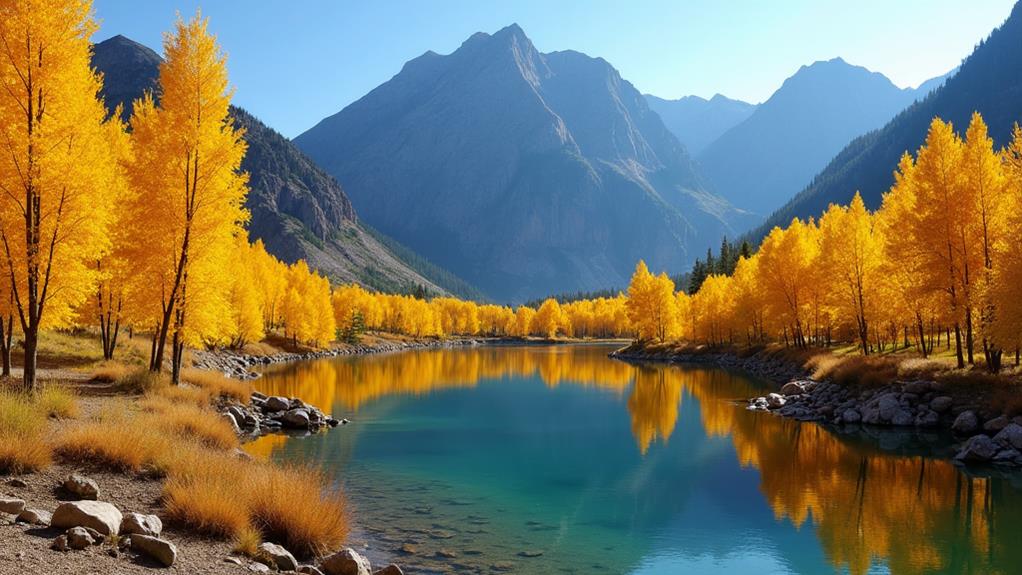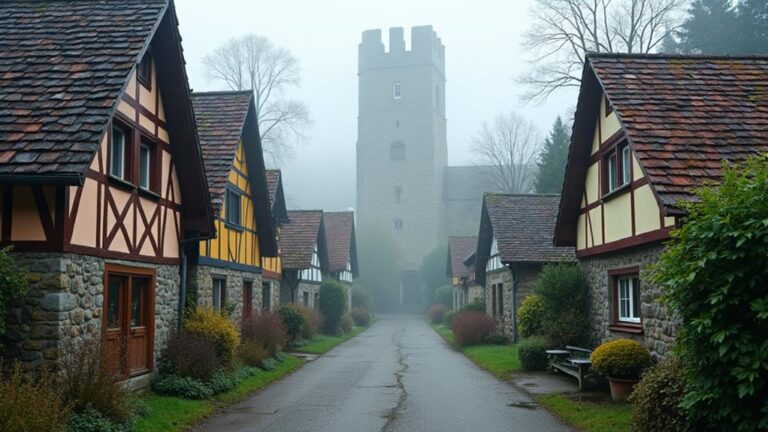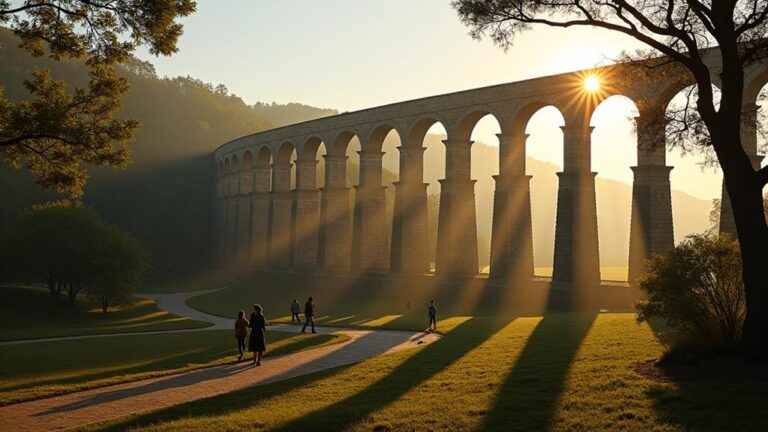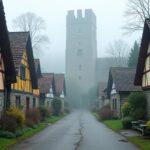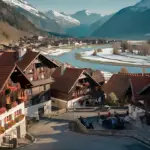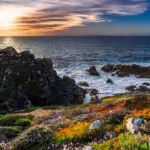As you prepare for a Colorado fall getaway, you're likely wondering where to find the state's most stunning autumn displays. From the golden hues of Aspen to the vibrant colors of Rocky Mountain National Park, the options are endless. But which spots truly stand out from the rest? You'll want to explore the top destinations for witnessing Colorado's breathtaking fall colors. This lineup features 10 must-visit locations, each offering a unique perspective on the state's autumnal beauty – but where do they rank, and which one will be the crown jewel of your trip?
Contents
- 1 Key Takeaways
- 2 Aspen's Vibrant Gold Rush
- 3 Rocky Mountain National Park
- 4 Telluride Fall Festivities
- 5 Kebler Pass Colorful Hike
- 6 Crested Butte Wildflower Trails
- 7 Maroon Lake Reflections
- 8 San Juan Mountains Scenic
- 9 Estes Park Foliage Tour
- 10 Slumgullion Pass Colors
- 11 Blue Lakes Trail Hike
- 12 Frequently Asked Questions
- 12.1 What Is the Best Time to See Fall Colors in Colorado?
- 12.2 Are Fall Color Reports Available for Specific Locations?
- 12.3 Can I Camp in Rocky Mountain National Park During Fall?
- 12.4 Are There Fall Color Festivals in Other Colorado Towns?
- 12.5 Are Any Fall Color Routes Accessible for Those With Disabilities?
- 13 Conclusion
Key Takeaways
- Aspen's unique geography and quaking aspens create an ideal environment for vibrant fall colors.
- Rocky Mountain National Park offers breathtaking mountain vistas and a tapestry of gold, orange, and crimson during fall.
- Crested Butte Wildflower Trails feature a range of trails with varying difficulty levels amidst stunning fall colors.
- Maroon Lake's calm surface creates perfect conditions for mirror reflections of changing aspen and evergreen trees.
- San Juan Mountains Scenic Byway showcases historic mining towns and breathtaking fall views in the region.
Aspen's Vibrant Gold Rush
Aspen's vibrant gold rush is one of the most spectacular fall color displays in North America, and you're in for a treat when witnessing it.
This natural phenomenon is deeply rooted in Aspen's history, dating back to the 1870s when silver miners settled in the area.
The town's unique geography, with steep mountain slopes and a relatively flat valley floor, creates an ideal environment for aspens to thrive.
Aspens, specifically the quaking aspen (Populus tremuloides), are a keystone species in these ecosystems, and their fall colors are a result of a complex process involving temperature fluctuations, daylight hours, and soil moisture.
As the days shorten and temperatures decrease, the production of chlorophyll slows, allowing the hidden pigments of carotenoids and anthocyanins to shine through, producing the characteristic golden hues.
Aspen's geography also plays a pivotal role in the display of fall colors, as the surrounding mountains create a microclimate that fosters an ideal environment for aspens to grow.
The high altitude and well-drained soil contribute to the trees' ability to thrive, resulting in vibrant displays of gold that attract visitors from around the world.
Rocky Mountain National Park
If you're looking for another fall color spectacle that rivals Aspen's vibrant gold rush, head to Rocky Mountain National Park in Colorado, where the varied elevation and diverse tree species create a kaleidoscope of autumn hues.
With over 60 mountain peaks above 12,000 feet, Rocky Mountain National Park offers breathtaking mountain vistas that are unmatched anywhere else in the state.
The park's alpine forests, dominated by quaking aspen, subalpine fir, and Engelmann spruce, transform into a vibrant tapestry of gold, orange, and crimson during the fall season.
To experience the best of the park's fall colors, consider the following:
- Drive the Trail Ridge Road: This 48-mile scenic drive takes you through a range of ecosystems, from montane forests to alpine tundras, offering unparalleled views of the surrounding mountains.
- Hike to alpine lakes: Lakes such as Bear Lake and Sprague Lake offer serene surroundings and stunning reflections of the surrounding mountains.
- Explore the Kawuneeche Valley: This valley is home to a diverse range of tree species, including aspen, cottonwood, and willow, creating a colorful display of fall hues.
Telluride Fall Festivities
As you explore Telluride during the fall season, you'll find the town hosts various events that showcase its vibrant culture.
The Telluride Town Events calendar is filled with festivities, from historic walking tours to art exhibitions, offering something for every interest.
One of the most notable events is the Telluride Bluegrass Music Festival, which brings world-renowned musicians to the town's scenic stages.
Telluride Town Events
The historic mining town of Telluride transforms into a vibrant hub of activity during the fall season, with various town events that showcase its unique blend of culture, entertainment, and breathtaking natural beauty.
As you stroll through the town's charming streets, you'll discover remnants of its rich Town History, from the iconic New Sheridan Hotel to the quaint miners' cottages.
Telluride's Town History is palpable in its architecture, cuisine, and community spirit.
Local Legends, such as Butch Cassidy and the Sundance Kid, have left an indelible mark on the town's folklore.
You'll find their stories etched in the town's museums, galleries, and even the local pubs.
Here are ways to experience Telluride's town events:
- Telluride Farmers' Market: Every Friday, the town hosts a bustling farmers' market, featuring local produce, artisanal goods, and live music.
- Telluride Heritage Tours: Join a guided tour to explore the town's historic landmarks, such as the old Jail, the Courthouse, and the iconic Opera House.
- Telluride Museum: Visit the Telluride Museum to uncover the town's rich mining history, geology, and Native American heritage.
Bluegrass Music Festival
Vibrant bluegrass rhythms and melodies fill the crisp mountain air during the Bluegrass Music Festival, a beloved Telluride fall festivity.
You'll experience the best of mountain tunes as world-class musicians take the stage, showcasing their technical prowess on instruments like the banjo, fiddle, and mandolin.
The festival's eclectic lineup features both traditional and contemporary bluegrass acts, ensuring there's something for every music lover.
As you immerse yourself in the festival vibes, you'll notice the picturesque backdrop of Telluride's mountains, which provides a unique and breathtaking setting for the event.
You can expect to hear intricate instrumental arrangements, heartfelt vocal harmonies, and storytelling through lyrics that often reflect the beauty of the great outdoors.
With its stunning natural scenery and lively atmosphere, the Bluegrass Music Festival is an unforgettable experience that perfectly captures the essence of Telluride's fall festivities.
Kebler Pass Colorful Hike
Perched atop the West Elk Mountains in western Colorado lies Kebler Pass, a scenic route renowned for its kaleidoscope of fall colors.
As you hike through Kebler Pass, you'll be surrounded by the remnants of a rich geological history.
The pass is situated near the Maroon Formation, a geological feature that dates back over 300 million years to the Pennsylvanian period.
This unique geological feature is a result of millions of years of erosion, which exposed a wide variety of minerals, including limestone, sandstone, and shale.
Kebler Pass's colorful hike is characterized by:
- Unique Mineral Composition: The area's mineral composition is primarily composed of limestone, sandstone, and shale. These minerals give the surrounding landscape its distinct colors and textures.
- Geological Formation: The Maroon Formation, a geological feature that dates back over 300 million years, is responsible for the area's unique landscape.
- Erosion Patterns: Millions of years of erosion have exposed the minerals, creating a diverse range of colors and textures that are visible during the fall season.
As you hike through Kebler Pass, you'll have the opportunity to witness the unique geological features that have shaped this scenic route.
Crested Butte Wildflower Trails
When you plan to visit Crested Butte Wildflower Trails, you'll want to know the prime wildflower bloom periods, which typically occur from mid-July to early September.
As you prepare for your hike, it's also essential to ponder the trail difficulty levels, ranging from easy strolls to more challenging climbs, to guarantee a safe and enjoyable experience.
Wildflower Bloom Periods
Typically, the Crested Butte Wildflower Trails experience peak wildflower bloom periods between mid-July and late August.
You can expect vibrant displays of Summer Blooms, such as gentians, asters, and goldenrods, which paint the landscape with hues of purple, pink, and yellow.
As you hike along the trails, keep an eye out for the Early Risers – the first flowers to bloom in late June and early July – like lupines, delphiniums, and columbines.
The timing of the wildflower bloom periods largely depends on factors such as elevation, temperature, and precipitation.
Three key factors to weigh:
- Elevation: Higher elevations tend to have shorter bloom periods, typically from late July to early August, due to the shorter growing season.
- Temperature: Warmer temperatures can trigger earlier blooms, while cooler temperatures may delay them.
- Precipitation: Adequate moisture is essential for healthy plant growth, and a well-timed rain can trigger a spectacular bloom.
Understanding these factors can help you plan your visit to the Crested Butte Wildflower Trails and maximize your chances of witnessing the stunning Summer Blooms and Early Risers.
Trail Difficulty Levels
While hiking the Crested Butte Wildflower Trails, you'll encounter a range of trails with varying levels of difficulty.
Easy trails, such as the Lower Loop Trail, are perfect for families or beginners, offering a gentle, 1.5-mile walk through a picturesque meadow filled with wildflowers.
This trail is well-maintained and relatively flat, making it accessible for hikers of all ages.
On the other hand, challenging routes, such as the West Maroon Trail, are designed for experienced hikers.
This trail is 10 miles long and features a steep incline, with an elevation gain of over 2,000 feet.
You'll need to be in good physical condition to tackle this trail, which takes you through dense forests and offers breathtaking views of the surrounding mountains.
When planning your hike, be sure to check the trail conditions and difficulty level to verify that you're prepared for the challenge.
Bring plenty of water, snacks, and sunscreen, and consider bringing a map or GPS device to help navigate the trails.
Best Viewing Times
The Crested Butte Wildflower Trails are best experienced during the peak blooming seasons, usually mid-July to early September.
You can expect vibrant colors and a diverse range of wildflowers, including lupines, sunflowers, and gentians.
To plan your visit, check the color forecasts, which are usually available a few weeks in advance. These forecasts can help you determine the best time to visit based on the current condition of the wildflowers.
Some key factors to weigh when planning your visit:
- Peak seasons: The peak blooming seasons typically occur during the summer months, but the exact timing can vary depending on weather conditions.
- Color forecasts: Check the official Crested Butte Wildflower Trails website or social media channels for color forecasts, which are usually updated weekly.
- Elevation: Take into account the elevation of the trails you plan to hike, as the higher elevations tend to bloom later than the lower ones.
Maroon Lake Reflections
Maroon Lake Reflections is a world-renowned scenic destination in Colorado that's catching the eye of many visitors as fall colors come alive.
You'll find this picturesque spot in the Maroon Creek Valley, where the Maroon Bells – two 14,000-foot peaks – mirror themselves in the lake's calm surface.
The lake's calmness creates the perfect conditions for mirror reflections, allowing you to capture stunning images of the surrounding aspen and evergreen trees.
As you stand at the lake's edge, you'll notice the vibrant colors of the changing leaves reflected in the water.
The soft ripples of the lake's surface create a sense of movement, while the surrounding mountains stand still, providing a striking contrast.
The mirror-like reflections are a result of the lake's shallow water and the lack of strong winds in the valley, making it an ideal spot for capturing the beauty of the fall colors.
When visiting Maroon Lake Reflections, consider arriving early in the morning or late in the afternoon to avoid the crowds and capture the best light for your photos.
San Juan Mountains Scenic
As you explore the San Juan Mountains, you'll find numerous scenic mountain drives that showcase the region's vibrant fall colors.
You'll pass through historic mining towns, many of which still retain their original architecture and charm, offering a glimpse into the area's rich mining history.
The breathtaking fall views in this region are particularly renowned for the changing hues of the aspen groves and the rugged mountain peaks that surround them.
Scenic Mountain Drives
Traveling through the San Juan Mountains Scenic Byway, you'll experience some of Colorado's most breathtaking fall colors.
This 236-mile scenic drive takes you through rugged mountain vistas and picturesque valleys, providing endless opportunities to soak in the vibrant fall foliage.
As you make your way through the San Juan Mountains, you'll pass through historic towns and quaint villages, each with its own unique charm and character.
The San Juan Mountains Scenic Byway offers a diverse range of landscapes and ecosystems, from alpine tundras to aspen groves, each with its own distinct fall color palette.
To fully appreciate the beauty of this scenic drive, consider the following tips:
- Timing is everything: The peak fall color season in the San Juan Mountains usually occurs in late September to early October, so plan your trip accordingly.
- Be prepared for variable weather: The San Juan Mountains are known for their unpredictable weather, so be sure to check the forecast and pack accordingly.
- Take your time: The San Juan Mountains Scenic Byway is a drive to be savored, so take your time and enjoy the stunning mountain vistas and fall foliage.
Historic Mining Towns
Numerous historic mining towns dot the San Juan Mountains Scenic Byway, each with its own rich history and unique character.
As you drive through this scenic route, you'll discover charming towns that once thrived on mining activities. You'll find remnants of mining history in the architecture, museums, and historic sites that still stand today.
Silverton, for instance, boasts a well-preserved historic district with colorful Victorian-era buildings that now house shops, restaurants, and museums.
In Lake City, you'll see preserved buildings from the late 1800s and early 1900s, showcasing the town's mining heritage.
Ouray, another mining town, has charming streets lined with historic buildings that now serve as hotels, shops, and eateries.
These towns still exude a sense of mining history, with remnants of old mines and equipment on display.
As you walk through the streets, you'll experience the authentic town charm that has been preserved over time.
The narrow streets, historic buildings, and friendly locals all contribute to a unique atmosphere that's steeped in the region's mining past.
Each town offers a distinct glimpse into Colorado's mining history, making them a must-visit during your San Juan Mountains Scenic Byway journey.
Breathtaking Fall Views
Perched amidst the rugged San Juan Mountains, the scenic byway transforms into a kaleidoscope of colors during the fall season.
As you drive through the San Juan Mountains Scenic, you're treated to breathtaking fall views of mountain vistas and fall landscapes.
The byway's 236 miles of stunning scenery weave through historic mining towns, alpine forests, and mountain peaks.
You'll witness an explosion of color as aspens, oaks, and maples change colors, casting a warm glow across the rugged terrain.
The mountains' diverse geology adds depth and texture to the scenery, with ancient rocks and volcanic formations creating a dramatic backdrop for the fall colors.
Some key highlights of the San Juan Mountains Scenic include:
- Dallas Divide: Offers panoramic views of the San Juan Mountains and the surrounding landscape.
- Red Mountain Pass: Features a scenic overlook with stunning views of the San Juan Mountains and the historic mining town of Silverton.
- Mill Creek: Provides a tranquil atmosphere with fall colors reflected in the calm waters of the creek.
Estes Park Foliage Tour
As you set your sights on Estes Park, a scenic mountain town at the entrance of Rocky Mountain National Park, you'll discover a haven for leaf peepers. With its rich Estes Park History, dating back to the early 20th century, the town has evolved into a popular destination for outdoor enthusiasts. When it comes to Fall Photography, Estes Park offers a diverse range of landscapes and compositions.
To make the most of your Estes Park Foliage Tour, consider the following scenic drives and trails:
| Trail/Drive | Description |
|---|---|
| Bear Lake Trail | A 0.8-mile loop around Bear Lake, offering stunning views of aspen and evergreen trees. |
| Fall River Road | A scenic drive that takes you through a mix of aspen, spruce, and fir trees, with the Big Thompson River running alongside. |
| Sprague Lake Loop | A 0.5-mile loop around Sprague Lake, featuring a picturesque landscape of aspen, pine, and spruce trees. |
| Upper Beaver Meadows | A scenic drive that takes you through a lush meadow, surrounded by aspen and evergreen trees. |
| Moraine Park | A scenic drive that takes you through a valley surrounded by aspen, pine, and spruce trees.
Slumgullion Pass Colors
Leaving the scenic drives of Estes Park behind, you'll find yourself drawn to the San Juan Mountains, where the changing colors of Slumgullion Pass await.
This mountain pass, with an elevation of 11,361 feet, offers breathtaking views of the surrounding peaks and valleys, especially during the fall foliage season.
The pass is a popular destination for leaf peepers and photographers, who come to capture the vibrant colors of the aspen, oak, and maple trees.
As you drive through the pass, you'll notice the unique geology of the area, with volcanic rocks and mineral deposits visible along the mountain roads.
The pass is also home to a variety of wildlife, including elk, deer, and bighorn sheep.
Some key facts to keep in mind when visiting Slumgullion Pass:
- Elevation: The pass has an elevation of 11,361 feet, which can cause altitude sickness in some individuals.
- Road Conditions: The mountain roads can be narrow and winding, with steep drop-offs and limited visibility in some areas.
- Weather: The weather in the pass can be unpredictable, with sudden changes in temperature and precipitation.
Blue Lakes Trail Hike
What draws you to the Blue Lakes Trail Hike, besides its proximity to Slumgullion Pass?
The Blue Lakes Trail Hike is a 8.5-mile out-and-back hike in the San Juan Mountains of Colorado, boasting stunning lake scenes and vibrant fall colors.
Situated at an elevation of 12,400 feet, this challenging hike rewards you with breathtaking views of the Blue Lakes, nestled in a picturesque valley.
The trail gains approximately 2,500 feet in elevation, with some sections featuring steep inclines and uneven terrain.
As you hike, you'll notice the vibrant colors of the aspen trees and the majestic peaks surrounding the valley.
Trail runners will appreciate the challenging terrain and stunning scenery, while hikers can take their time to soak in the views.
The Blue Lakes Trail Hike is an ideal destination for those seeking a strenuous hike with rewarding payoffs.
With its proximity to Slumgullion Pass and its stunning lake scenes, this hike is a must-visit for outdoor enthusiasts during the fall season.
The scenic views and challenging terrain make it an unforgettable experience for hikers and trail runners alike.
Frequently Asked Questions
What Is the Best Time to See Fall Colors in Colorado?
To see the best fall colors, you'll want to plan your trip during peak weeks, usually mid-September to early October, when aspens change colors. Take colorful drives through mountains, like the San Juan Skyway or Trail Ridge Road.
Are Fall Color Reports Available for Specific Locations?
You can track fall color progression using fall foliage trackers and colorful webcams, providing real-time updates on specific locations, helping you pinpoint peak colors and plan your trip to enjoy the vibrant autumn scenery accordingly.
Can I Camp in Rocky Mountain National Park During Fall?
Don't assume camping in Rocky Mountain National Park during fall is off-limits due to weather. You can camp there, but be aware: Park rules require campsite reservations, especially during peak fall season, usually booked months in advance.
Are There Fall Color Festivals in Other Colorado Towns?
You'll find numerous fall festivals across Colorado, such as the Telluride Blues & Brews Festival, Crested Butte's Alpenglow Arts Festival, and Paonia's Fall Fiesta, offering live music and craft beer, while Aspen hosts Aspen Afternoons.
Are Any Fall Color Routes Accessible for Those With Disabilities?
You'll find many accessible trails and wheelchair routes for fall color viewing, such as the Bear Creek Lake Park's paved trails and the Garden of the Gods' Perkins Central Garden Trail with ramps and paved pathways.
Conclusion
As you stand amidst Colorado's kaleidoscope of colors, the vibrant tapestry of aspens, alpine forests, and wildflowers weaves a breathtaking autumnal spectacle. The state's rugged peaks and picturesque valleys mirror the sky's brilliant hues, while scenic drives and hikes beckon you to immerse in the golden glow. With each step, the landscape unfolds like a masterpiece, as nature's brushstrokes paint an unforgettable picture of Colorado's 10 best fall colors.

